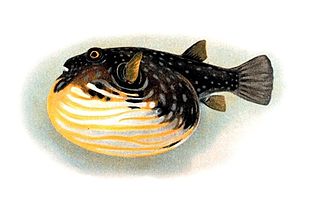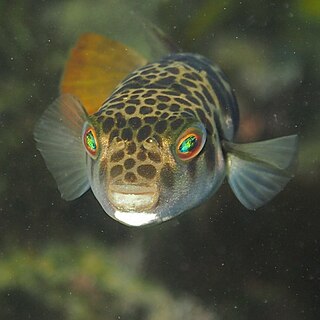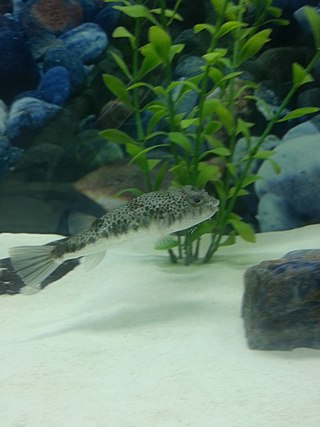
Tetraodontidae is a family of primarily marine and estuarine fish of the order Tetraodontiformes. The family includes many familiar species variously called pufferfish, puffers, balloonfish, blowfish, blowers, blowies, bubblefish, globefish, swellfish, toadfish, toadies, toadle, honey toads, sugar toads, and sea squab. They are morphologically similar to the closely related porcupinefish, which have large external spines.

Torquigener brevipinnis is a species of fish in the family Tetraodontidae. It is found in Australia, Indonesia, Japan, New Caledonia, Papua New Guinea, and the Philippines.

Torquigener is a genus of pufferfishes native to the Indian and Pacific oceans. Males of at least two Torquigener species are known to make elaborate circular nests on the seafloor.

Tetractenos is a genus of Tetraodontidae. The genus can be found throughout the Indo-West Pacific and Australia's southern and eastern coastlines.

The common toadfish, also known as the common toado, toadfish or toado, is a species of fish in the family Tetraodontidae of order Tetraodontiformes, found along Australia's eastern coast, from northern Queensland to Flinders Island, and around Lord Howe Island, as well as in New Zealand waters. It often buries itself in sand with only its eyes exposed.
Torquigener albomaculosus, or the white-spotted pufferfish, is the 20th discovered species of the genus Torquigener. The species was discovered in the ocean waters around the Ryukyu Islands in Japan off the south coast of Amami Ōshima Island. Observed depths of the species range between 10 and 27 m. The fish's head and body are colored brown with white spots at the back. Its abdomen is silvery-white with white spots.

Torquigener pleurogramma, commonly known as the weeping toadfish or blowie, is a species of fish in the family Tetraodontidae. It is found in the coastal waters of Australia. Its flesh is highly toxic.
Torquigener andersonae, commonly known as Anderson's toadfish, is a species of fish in the family Tetraodontidae. It is found in the coastal waters of southeastern Australia. It was described by Graham Hardy in 1983, who named it for a colleague at the University of New South Wales, Dr. Jennifer M. E. Anderson. It has been recorded from Jervis Bay and Bermagui on the southern New South Wales coast.
Torquigener squamicauda, commonly known as the brush-tail toadfish or scalytail toadfish, is a species of fish in the family Tetraodontidae. It is found in the coastal waters off eastern Australia from Yeppoon in Queensland to Wattamolla just south of Sydney in New South Wales.
Torquigener altipinnis, the highfin toadfish, is a species of fish in the family Tetraodontidae. It is found in the coastal waters off eastern Australia, from southeast Queensland to Malabar, New South Wales, as well as Norfolk, Lord Howe and Raoul Islands.
Torquigener perlevis, commonly known as the spineless toadfish, is a species of fish in the family Tetraodontidae. It is found in the coastal waters off northern and eastern Australia from the Gulf of Carpentaria to the Georges River and Botany Bay in Sydney, New South Wales.

Torquigener tuberculiferus, the fringe-gilled toadfish, is a fish of the pufferfish family Tetraodontidae native to the waters around Indonesia.
Torquigener paxtoni, commonly known as Paxton's toadfish, is a fish of the pufferfish family Tetraodontidae, native to Shark Bay.
Torquigener parcuspinus, commonly known as the yellow-eyed toadfish, is a fish of the pufferfish family Tetraodontidae, native to the eastern Indian Ocean, Indonesia, and northern Australia.
Torquigener pallimaculatus, commonly known as the rusty-spotted toadfish, is a fish of the pufferfish family Tetraodontidae native to the Indian Ocean and northern Australia.

Torquigener hypselogeneion, commonly known as the orange-spotted toadfish, is a fish of the pufferfish family Tetraodontidae native to the Indian Ocean and northwestern Australia.
Torquigener hicksi, commonly known as Hicks's toadfish, is a fish of the pufferfish family Tetraodontidae native to northern Australia.
Whitley's toadfish is a species of fish in the family Tetraodontidae that reaches a length of 9.8 cm, and is a host to Bianium plicitum.
The white-spotted pufferfish is known for its unique and complex courtship display which involves creating large, geometric circles in the sand. These circles are constructed in an effort to attract females for copulation. Males must maintain their circles in order to attract a mate. A female will evaluate the structure and choose to mate with the males after evaluation and completion of other mating behaviors.
Torquigener gloerfelti is a species of pufferfish in the family Tetraodontidae. It is native to the Western Pacific, where it is known from Bali Strait in Indonesia. The species is demersal and typically occurs at a depth range of 50 to 60 m.






